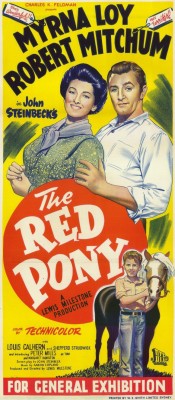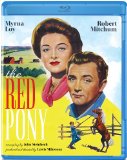| Reviews & Columns |
|
Reviews DVD TV on DVD Blu-ray 4K UHD International DVDs In Theaters Reviews by Studio Video Games Features Collector Series DVDs Easter Egg Database Interviews DVD Talk Radio Feature Articles Columns Anime Talk DVD Savant Horror DVDs The M.O.D. Squad Art House HD Talk Silent DVD
|
DVD Talk Forum |
|
|
| Resources |
|
DVD Price Search Customer Service #'s RCE Info Links |
|
Columns
|
|
|
Red Pony, The
Everything about it was first-rate. It was one of Republic's few films in three-strip Technicolor. (When they made color films at all, it was usually in the inferior, cheaper Trucolor process, a technology more or less controlled by Republic. Thank you, Barry Lane.) Lewis Milestone (All Quiet on the Western Front), who'd previously helmed the fine adaptation of Steinbeck's Of Mice and Men in 1939*, again directed. (Robert Aldrich was an assistant director, and actor-producer Norman Lloyd was Milestone's producing assistant.) Two major stars, Myrna Loy and Robert Mitchum, were borrowed from outside the company, and Aaron Copland, the "Dean of American Composers," wrote the musical score, which as a six-part suite became as famous all by itself.
Probably because the industry still regarded Republic as a lowly, second-rate film company, The Red Pony wasn't nominated for a single Academy Award or any other award for that matter. It frequently turned up on television in later years but is, unjustly, somewhat forgotten today.
It's usually described as a children's film though throughout the picture there's an intelligently realized undercurrent of tension and resentment among the adult characters. It's certainly not a boy-and-his-pony story although it's partly that, too.
Hopefully the film's reputation will rise now that Paramount, via Olive Films, is offering the film in a spectacularly good high-definition transfer. Though "unrestored" in the sense that there's still some speckling here and there and other minor flaws, it's still one of the best high-def transfers I've seen so far for a three-strip Technicolor movie.
Set in early 20th century California, near Salinas, the story is quite simple. Fred Tiflin (Shepperd Strudwick), a San Jose schoolteacher-turned-rancher, gives his young son, Tom (Peter Miles, the older brother of Gigi Perraeu), an expensive gift, a beautiful red pony that Tom names Gabilan. Working closely with ranch hand Billy Buck (Robert Mitchum), Tom responsibly begins training and caring for the pony. A trick Tom innocently teaches Gabilan, opening the stable door latch with its mouth, causes problems later when one day Gabilan lets itself out, is caught in a rainstorm, and later develops the strangles, becoming seriously ill.
The movie is less concerned about the relationship between the boy and his horse, which realistically is dramatized along the lines of the authentic relationships farmers and ranchers have with their animals. Instead, The Red Pony is more about the family dynamic. Fred buys Tom the expensive pony hoping to improve his cordial but emotionally distant relationship with his son. Instead, Tom turns to farmhand Billy, relying upon him for all the pony-rearing advice. Fred projects his resentment by lashing out at his garrulous father-in-law (Louis Calhern, giving the film's best performance), a colorful former Oregon Trail wagon master who tiresomely retells the same stories of his experiences in the Old West over and over again.
(With his flowing white hair and beard the grandfather strongly resembles Buffalo Bill Cody, a role Calhern would play the very next year in Annie Get Your Gun.)
All this combined with undefined unhappiness between Fred and his wife, Alice (Myrna Loy), makes Fred feel like a stranger in his own home. After discussing the matter with Alice, they agree he should return indefinitely to his hometown of San Jose to think things through. Later, as the pony grows deathly ill, Fred returns home to support his son through the emotionally trying experience, but Fred's mere presence suddenly makes Tom realize that Gabilan might die.
Billy, on the other hand, in not wanting to hurt Tom's feelings, unrealistically assures him that the pony will recover. He also doesn't contradict Tom's misplaced anger when the boy wrongly blames Billy for the pony's illness.
The film, in part, is also about how children first encounter issues of mortality, and the various means adults allow or try to shield their offspring from that experience. "Can't know life unless you see death," says Tom's grandfather, who'd certainly have witnessed it on the Oregon Trail. "It's all part of one thing." When Fred races home to be with Tom, he's full of conflicted emotion because he hopes the death or near-death of the pony might draw him and son closer together.
The characters are altered slightly for the movie. Most particularly, in the stories Billy is rotund, middle-aged, and wears a walrus mustache. Mitchum is obviously none of these things, though through his performance and screen charisma it's easy to see how Tom would prefer his company to stick-in-the-mud Fred. However, the film and/or Mitchum don't project Billy's inflated ego as a self-proclaimed horse expert, the subtle pleasure he derives from Tom preferring his company to Fred's, or his error of judgment in not being realistic about the pony's chances for survival. (One might also speculate what Republic contractee John Wayne might have done in the role.)
But the movie is extremely well made throughout. The cheerful first third of the picture has several fantasy scenes, some incorporating animation effects by innovative animation upstart UPA. The second-half is, obviously, much darker, and includes a harrowing sequence with Tom fighting off large carrion birds certain to traumatize young children. I'm glad I decided to hold off showing this to my five-and-a-half year-old until she's a bit older.
Video & Audio
In its original full-frame, 1.37:1 format The Red Pony is a stunner, the refined use of three-strip Technicolor really shining here. The matrixes go out of alignment only once or twice, for a shot or two. The rest of the time the picture is crystal-sharp with rich hues that are exactly right and never too "hot." The Region A disc has good audio, English only with no subtitle options. This title really cries out for an audio commentary with a Steinbeck scholar, or perhaps Norman Lloyd, Beau Bridges (who plays one of Tom's friends), and others, but Olive's license with Paramount permits no Extra Features, alas.
Parting Thoughts
Excellent on every level, The Red Pony remains one of the best films ever to come out of Republic Studios and despite the lack of supplements the movie and the transfer get high marks. A DVD Talk Collector Series title.
* Milestone and Steinbeck began adapting it soon after Of Mice and Men, even planning to reuse that film's stars, Burgess Meredith and Lon Chaney, Jr. Meredith, presumably would have played the father and Chaney the farmhand?
Stuart Galbraith IV is a Kyoto-based film historian whose work includes film history books, DVD and Blu-ray audio commentaries and special features. Visit Stuart's Cine Blogarama here.
|
| Popular Reviews |
| Sponsored Links |
|
|
| Sponsored Links |
|
|
| Release List | Reviews | Shop | Newsletter | Forum | DVD Giveaways | Blu-Ray | Advertise |
|
Copyright 2024 DVDTalk.com All Rights Reserved. Legal Info, Privacy Policy, Terms of Use,
Manage Preferences,
Your Privacy Choices | |||||||















